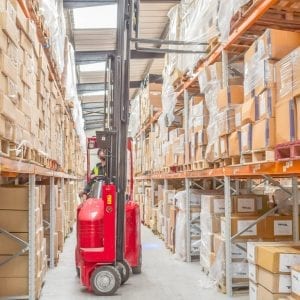
View original at www.logisticsmanager.com
A decreasing labour pool, increasing levels of e-commerce and a desire for high storage utilisation in the warehouse means articulated forklifts are in demand. Michelle Mooney investigates the highs and lows of forklift articulation and strips apart the features of Very Narrow Aisle (VNA) trucks. The articulation of forklifts means optimising their size, making them more streamline, easier to fit through narrow aisles, and simply making them capable of bending into smaller gaps than a standard forklift would be able to fit into. John Maguire, MD at Narrow Aisle, has noticed a growing trend from customers wanting more efficient models: “Warehouse operators want to store to ever greater heights and demand machines that are capable of picking and putting away pallets at height safely and cost efficiently.” That’s where narrow aisle forklifts come in: “The obvious benefit of narrow aisle technology is the fact that it maximises the pallet storage capacity of the building,” he says. This means that warehouses can limit excess space by introducing more pallets to their warehouses, because a smaller, more streamline vehicle can squeeze through those gaps. Maguire continues: “The Flexi AC 1200 increases usable storage space by between 25-50 per cent. And, because – like all models in the Flexi range – it is able to load and unload lorries from the side or from a dock and then deliver pallets directly to the pallet storage in a single operation, it eliminates double handling of loads and the need to operate a counterbalanced machine outside and a reach truck inside the store.” Maximising cube space Paul Berrow, MD at Translift Bendi, says: “There is so much uncertainty around at the moment that companies are looking to utilise existing warehouses and facilities in maximising the cube space. This has led to an increase in […]



Leave a Reply
You must be logged in to post a comment.